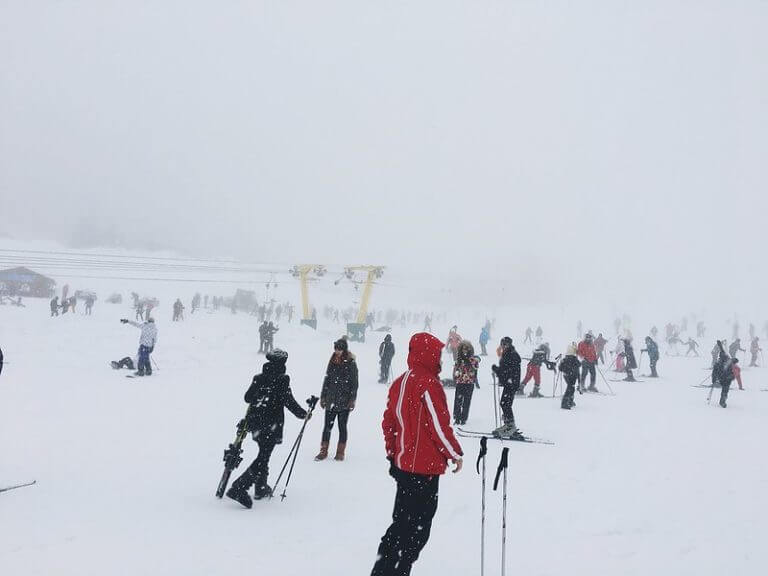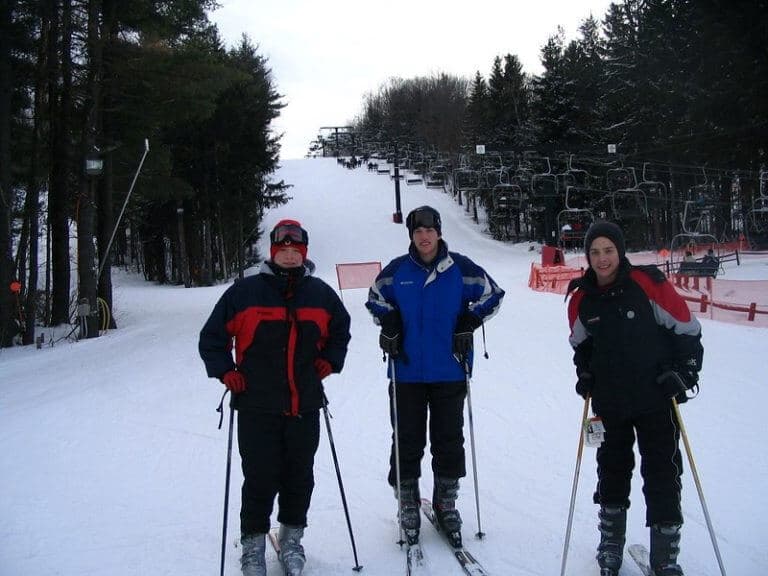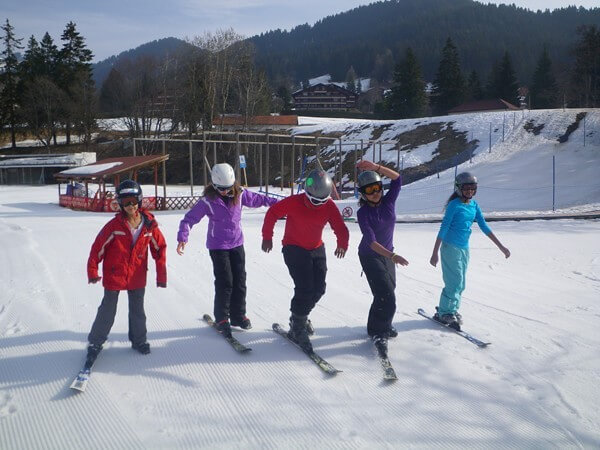Skiing is a fun and exciting activity for people of varying ages. However, it can be dangerous for both beginners and experts. If you are interested in learning how to ski, there are various things you may want to know. In this post, we’ll discuss the amount of time you will need to learn skiing, the dangers involved, and skiing safety tips for beginners.

How Long Does it Take to Learn Skiing?
One of the most common questions among new skiers is: how long will it be before I can know how to ski? Different people master things at different paces. However, it should take you at least an hour to learn how to stand, gain balance, and advance for some meters before slowly stopping.
It will be several hours before you can learn how to ski down a shallow slope and turn fast. Learning how to start skiing slowly and turning either left or right takes approximately two days while mastering parallel turns can take up to a week or two. It’s worth mentioning that acquiring robust skills and confidence to engage in mogul skiing, or jumping off-piste terrain can take many years.
Factors that Influence Ski Learning
If you are a sports enthusiast and a fast learner, chances are that you will master skiing within a short time. However, if you have no sports experience, it could take you some weeks before you can finally master skiing skills. Some of the things that can have an impact on your learning curve include;
· Age
While you can learn skiing at any age, the older you get, the longer it takes to learn. Younger people will learn how to ski easier and faster.
· Strength and Fitness
The more fit you are, the better and faster you can learn and master how to ski. However, unfit people can still ski but mastering the skills will take much longer.
· Passion and confidence
Are you passionate about skiing? Fear is understandable at the beginning. However, you need to overcome the fear, be passionate, and avoid being over-confident. This will ease and accelerate your learning process.
· Balance
Learning how to control and balance your feet plays a huge role in boosting your learning curve. Practice and master balance skills by engaging in other activities such as squash, ice skating, and slack lining.
Dangers Involved in Skiing

There are various dangers you may come across while skiing. As a beginner, being conversant with skiing safety tips is the first step to protecting yourself from harm. Here are some of the skiing dangers you should beware of.
· Skiing Off a Cliff
Skiing off a cliff can be life-threatening. Beginners are more susceptible to this danger due to their lack of adequate training, knowledge, and experience. However, seasoned skiers sometimes make this mistake.
Some of the skiing accidents reported between the 1980s and 1990s were a result of skiers going over the cliff. Skiers can avoid these mistakes by mastering skiing safety tips on how to avoid obstacles, mastering their stopping skills, and understanding trail markings.
· Snow Immersion Suffocation (SIS)
Snow immersion suffocation occurs when somebody is buried under the snow. SIS is rare albeit more common than avalanches. Skiers may experience SIS by falling into a tree well which is usually hidden from view.
Often, skiers will be buried by snow barring them from escaping. As a result of pressure and lack of oxygen, skiers can suffocate within minutes. Skiers can avoid SIS by being conversant with the surroundings and avoiding barriers such as trees. Skiing with a partner and watching over each other can help reduce the risk of SIS.
· Avalanches
Avalanches are natural tragedies that can be triggered by various things. For instance, skiers may interrupt snow-packed snow forcing ice layers to fall. No skiing safety tips can prepare skiers for an avalanche and this makes them even more dangerous. Avalanches have been a major cause of death in the US in the past decade. Beginners can avoid avalanches by skiing on safe regulated slopes and skiing in small groups to avoid interrupting the slopes.
· Hypothermia
Skiers can suffer from hypothermia if they lack proper protective gear. Hypothermia occurs as a result of insufficient coverage and overexposure to excess cold weather. It often occurs when the body temperature drops below 98 degrees Fahrenheit. Symptoms of hypothermia include; confusion and shaking.
Death may occur in severe circumstances. You need to be armed with the right skiing safety tips to avoid hypothermia. For instance, be fully prepared with the right gear which includes a thick jacket and sufficient accessories to cover every part of the body. If you are exposed to excess cold, you may want to take shelter and warm your body up.
· Acute Mountain Sickness (ACM)
Acute mountain sickness occurs when skiers access the highest points of the mountain. Oxygen levels decrease at high elevations and ACM can affect skiers when they are 2500m above sea level. Symptoms of ACM include; dizziness, vomiting, swelling of the body, and shortness of breath.
To avoid ACM, skiers should monitor their altitude and maintain healthy levels. Having a partner or staying in a group is recommended. That way, you can watch one another. If you notice that your partner has suffered ACM, the best thing is to descend as soon as possible.
· Frostbite
Frostbite also results from insufficient coverage. It often affects the toes and fingers. You can start feeling the effects of frostbite after 30 minutes of exposure to extreme cold. One of the skiing safety tips to avoid frostbite is to wear thick gloves. Always wear warm socks and avoid removing your ski boots.
· Broken Leg
Suffering broken legs during a skiing trip can occur when skiers lose control and fall while skiing. However, this is a rare accident and beginners can avoid it by exercising to strengthen their leg muscles. Maintaining a ski angle of approximately 45 degrees and reducing strain on the legs helps prevent broken legs.
Skiing Safety Tips you should beware of

Wearing a certified ski helmet is one of the skiing safety tips that you should beware of. Here are more tips. Having protective ski headgear can save you from severe head injuries should you fall while skiing.
· Exercise in Advance
You need to be in good shape to have an effective skiing session. Beginners should start exercising in advance before they can start learning how to ski.
· Dress Accordingly
Wear the right clothing including a helmet liner, a headband or a helmet liner. Wear layers of clothing as well. Don’t forget your mittens and gloves. Carrying an extra pair of clothing comes in handy if the first pair gets wet.
· Use the Right Ski Equipment
Avoid borrowing ski equipment. Instead, opt to rent from a ski shop. Many ski resorts also have a wide range of ski equipment for you to choose from. Whether you opt to rent or buy your ski equipment, try your ski boots to ensure they fit properly.
Your bindings should also be well adjusted. You should conduct research and compare the available ski equipment brands before choosing one that meets your needs.
· Get Formal Instructions
As a beginner, you will need ski lessons before you can finally embark on live ski lessons. Remember, even seasoned skiers get refresher courses from time to time.
· Rest
If you feel tired, you may want to take a break to rest at the resort. Eat well and drink enough water before resuming your skiing session. Remember, skiing takes up lots of energy and you will need sufficient energy to ski effectively.
· Wear Goggles
Wear well-fitting ski goggles around your helmet. If you use eyeglasses, choose goggles that fit appropriately around your eyeglasses. You can also consider prescription goggles.
· Be Cautious
While skiing, you need to focus on the task at hand. Often, accidents happen when skiers get distracted and lack concentration. Both beginners and experienced skiers should avoid skiing on overly elevated ski levels.
· Know and Understand Your Limits
Never attempt to ski trails that exceed your skill level. Trails are well marked to help you stay within your limits. Further, maintain control of your skis and concentrate on your skiing trail.
· Partner with a Friend
Skiing with a friend is a good idea because both of you can watch over each other. Have a designated place where you can meet if you get separated. You may want to use walkie talkies too to connect.
· Stick to the Rules
Every ski resort will have skiing rules that you should abide by. Be on the lookout for the warning signs as well to be on the safe side.
Finally
Practice these skiing safety tips to be safe on the ski trail. Remember, both beginners and experts need regular training to master and enhance their skiing skills. Novice skiers especially need ski lessons before they can participate in the activity. Identify a qualified, reliable, and experienced ski trainer. Many ski resorts have professional trainers who you can rely on to enhance your skills. Skiing is easy to learn but hard to master. However, you can advance your expertise with regular training.

